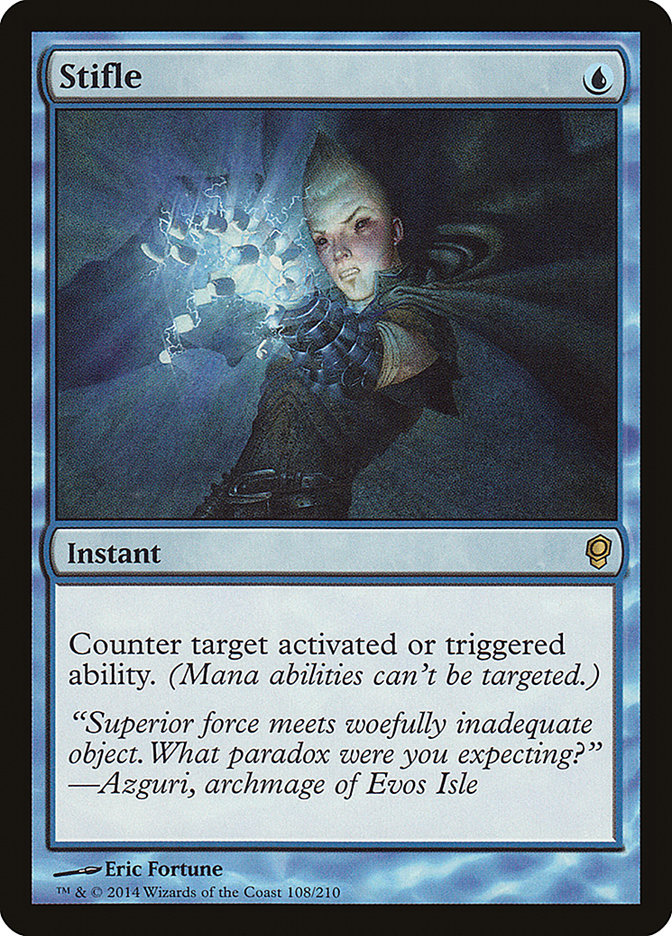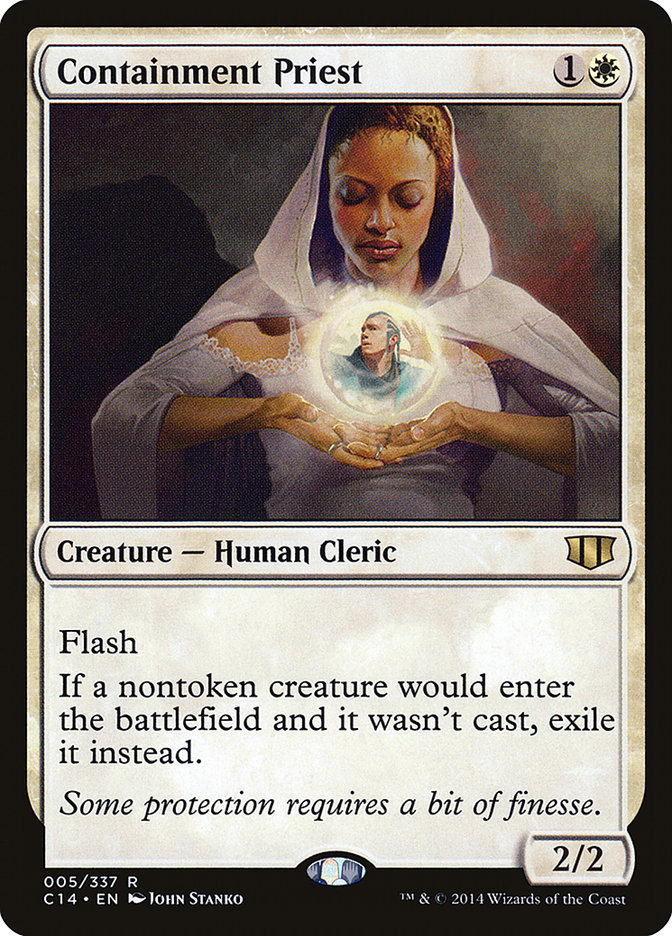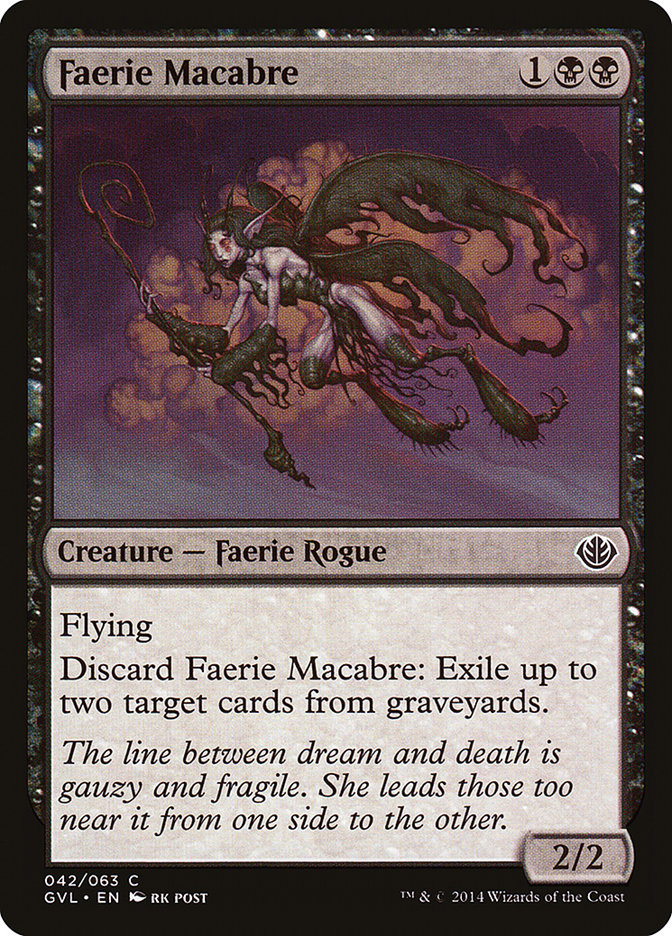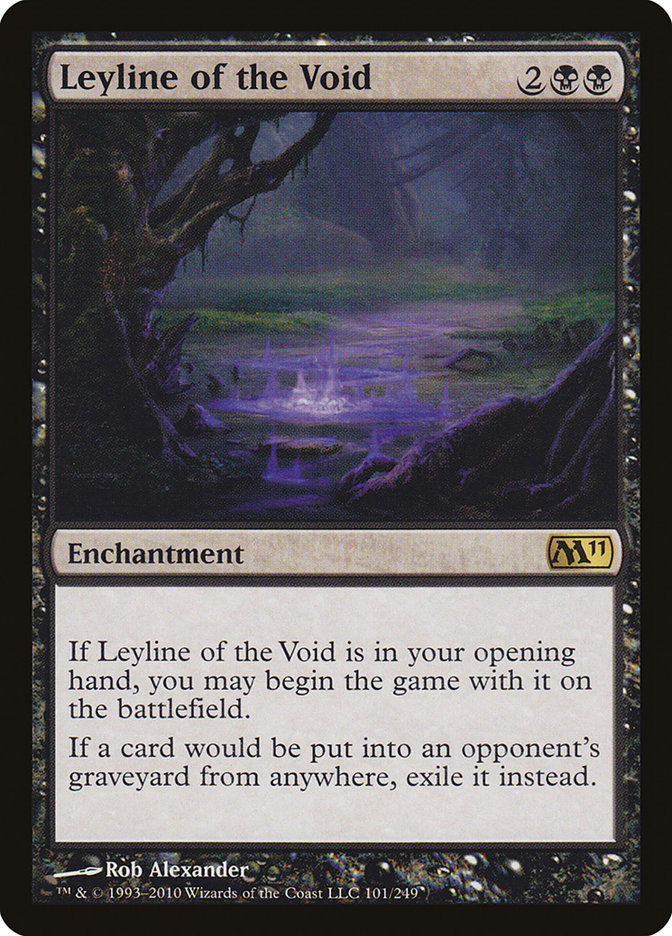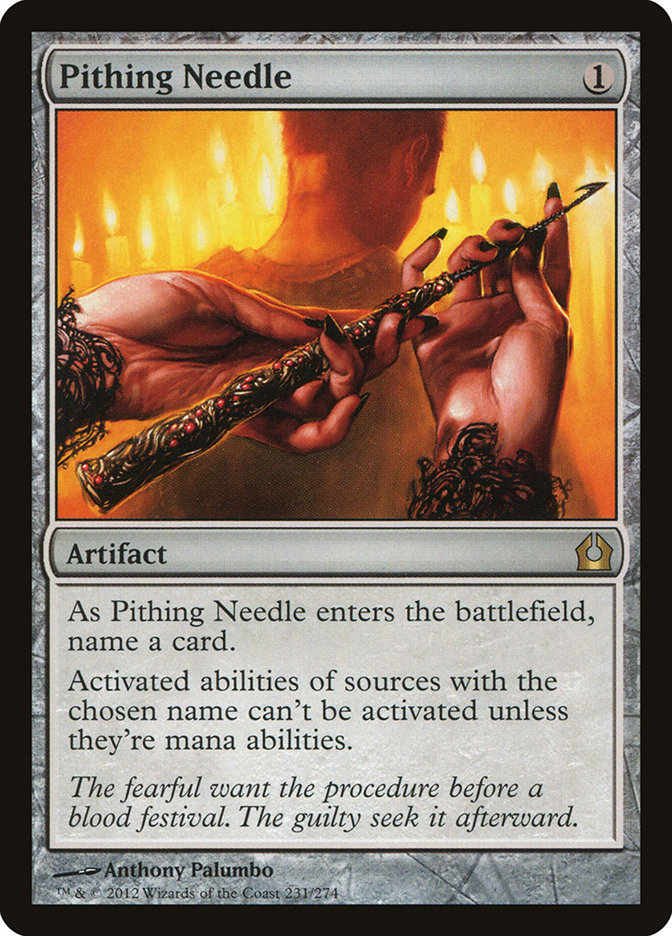Temur Delver. Death and Taxes. Sneak and Show. Reanimator. Lands. Miracles.
These are your targets. The best, most popular, most obvious decks in
Legacy now that we have a few weeks of Magic Online results and a Team
Constructed Open in Worcester to digest. How do we beat them? I’m glad you
asked.
Creatures (12)
Lands (18)
Spells (30)

There are three main ways to lose to Temur Delver. The first is their
annoying nut draw. You know the type. Delver, Delver + Wasteland, Daze,
flip both Delvers, attack, Force of Will your next play, attack again, toss
some Lightning Bolts upstairs, good game. This type of top-notch draw is
going to beat most decks when Temur wins the die roll. It’s just the way it
is.
The second is getting Stifled out of the game before it gets started.
Getting hit with two one-mana Stone Rains can often just mean the game.
This is probably the most frustrating way to lose, as it’s Delver’s way of
playing like a Ponza deck without having to, you know, devote any bad cards
to the gameplan.
The third is losing to Nimble Mongoose in the mid-late game. This isn’t
much of a concern for combo decks, but for fair Brainstorm decks, you can
often just run dry on answers for the Goose. Often, one finds themselves
just flooding out while Temur stays smooth on two or three lands the whole
game.
Of course, there are alternatives, like the True-Name Nemesis plan (which
is essentially the same way to lose as the Mongoose plan, but more
mana-intensive and invulnerable to Baleful Strix, Tarmogoyf, Gurmag Angler,
or opposing True-Name Nemesis). There are the Life from the Loam and Sylvan
Library jukes, which can put Temur Delver ahead on material going long. For
the most part, though, you’re going to lose to one of those scenarios.
What is the solution, then?
You’re going to lose almost every game where you lose the die roll and your
opponent has their nut draw (barring a nut-draw Reanimator start, of
course, with Chancellor of the Annex + Unmask + turn-one combo). Welcome to
Legacy, it’s part of life. The top-shelf draws are truly broken.
What about the Stifle games?
Well, for most fair Brainstorm decks, there’s going to be no
deckbuilding-oriented way to avoid the Stifle wins. If you draw a hand
where most of your lands are fetchlands, the solution is to not walk into
Stifle, to slowroll the fetches, to force your opponent to hold up their
own mana for Stifle and just make your land drops turn after turn. If you
see an opportunity to go for a mass fetchland-cracking turn, go for it. If
you can get three or four lands on the battlefield while your opponent
holds up one or two lands to threaten Stifle, you can play the game on your
terms. On the contrary, if your opponent has a threat clocking you, there’s
often no recourse but to slam those fetchlands and hope that your opponent
doesn’t have the Stifles to punish you.
Of course, the natural solution is to play no Stifle-able lands, which
means Death and Taxes is the deck to play to avoid this fate. As Temur
Delver gains popularity in the wake of the Deathrite banning, Death and
Taxes has thus risen as a natural predator. Colorless Eldrazi is similarly
powerful against this axis of the Delver gameplan and is generally just a
tremendously powerful deck against Temur Delver in general. Almost every
other deck in the format plays fetchlands in some quantity, though, so it
means that cagey play will be more important than deckbuilding
considerations.
As for the Nimble Mongoose plan, the best solution is simple. Play your own
fat creatures to clog up the battlefield! This means your own Tarmogoyfs,
Gurmag Anglers, True-Name Nemesis, Stoneforge Mystic + Batterskull, or
Eldrazi creatures. Failing that, Rest in Peace is a possible plan to defeat
both Tarmogoyf and Nimble Mongoose in one neat package.
Healthy doses of removal, possible Rest in Peace to attack the
graveyard-reliant creatures, and several must-answer creatures. That’s the
recipe for success.
This leads to the following solid options for beating Temur Delver:
- Death and Taxes
- Colorless Eldrazi
- Jeskai Delver
Miracles is another tolerable option, and Reanimator is its usual
glass-cannon self, able to beat anything with the nut draw and unable to
put up even a semblance of a defense when the cards don’t materialize.
Lands, of course, is generally favored against fair Brainstorm decks, one
of which is Temur Delver. It must be ahead in the matchup by the numbers.
Sneak and Show, similarly, can beat Delver with the right draw, but is
theoretically not favored in the matchup against the disruptive aggro deck.
Storm, similarly, can Duress its way to victory against many Temur draws.
Stoneblade, if it can get enough mana, is likely able to outmuscle Delver
as well.
One might think then, that Temur Delver is not favored against much of the
format! A seductive line of reasoning, to be sure.
Of course, as Mike Tyson once famously said, “Everyone has a plan until
they get punched in the mouth.” Temur Delver will always have equity in
these matchups simply by virtue of its ability to shift gears and pinpoint
the exact axis the opponent doesn’t want to fight on, and then
drive all of its resources towards that axis. Whatever you do, whatever
deck you choose, don’t treat the Temur Delver matchup as a gimme. It’s
never as easy as it seems.
Creatures (25)
- 4 Mother of Runes
- 4 Flickerwisp
- 4 Stoneforge Mystic
- 1 Mirran Crusader
- 2 Phyrexian Revoker
- 4 Thalia, Guardian of Thraben
- 2 Recruiter of the Guard
- 2 Brightling
- 2 Remorseful Cleric
Lands (18)
Spells (17)

Death and Taxes is going to beat you with mana denial, a battlefield full
of untouchable creatures, and a slow pick-apart gameplan that requires you
to jump through a bunch of hoops to keep from getting squeezed out.
Fortunately, Death and Taxes relies on a few specific cards to do a ton of
work, because if the protection and disruption pieces don’t survive, the
deck turns into a wimpy pile of white creatures. What you need to do is
play some cards that offer you repeatable or card-advantageous ways to
break out of or break through the lock creatures. These are simple:

Additionally, the deck is ultra-reliant on its artifacts to bring things
home, so Shatter effects are always welcome. Pithing Needle, too, can shut
down opposing Aether Vials or Mother of Runes to weaken the lock or mana
advantage elements of the deck. Null Rod does it all at once, shutting down
Vial and equipment with equal ease. Even Containment Priest can be a nice
pickup to defeat Aether Vial and any stray Flickerwisp activations
targeting D&T’s own value creatures.
Death and Taxes is much more exploitable than Temur Delver by virtue of its
focus on creatures, but it, too, is significantly harder to pin down than
it would seem at first blush. The key is turning the corner and putting the
opponent on the defensive, because eventually, the lock pieces will come
around and get you if you don’t push an early advantage.
Creatures (8)
Lands (16)
Spells (36)
- 4 Brainstorm
- 4 Show and Tell
- 4 Force of Will
- 1 Mountain
- 3 Island
- 4 Sneak Attack
- 4 Lotus Petal
- 4 Ponder
- 2 Spell Pierce
- 3 Preordain
- 1 Flusterstorm
- 2 Omniscience
Sideboard

Sneak and Show is relatively resilient to simple Dazes and Force of Wills.
If you give it sufficient time, it will assemble the combo through tons of
countermagic. Temur Delver can push through it with a fast clock and a few
counterspells, but sometimes the Delver player can’t win the game before
Sneak and Show fights through the disruption and sticks a massive threat.
Discard, too, helps a lot, but the presence of such powerful cantrips means
that Sneak and Show is going to beat a few Thoughtseizes that don’t precede
a threat. You can hammer them with six or more discard spells backed up
with countermagic before winning with an eventual threat, but it is
surprisingly tricky.
To beat this deck, though, is not super difficult. Containment Priest is
incredible as a permanent-based answer that shuts down the deck entirely.
Reanimator as a deck is just faster than Sneak and Show, with the potential
to just hold a Griselbrand and make it impossible for Sneak and Show to
ever cast a Show and Tell. Karakas is amazing as a disruptive measure that
forces the opponent to have a Sneak Attack with excess mana to actually
win. Often Sneak and Show pilots play a few copies of Omniscience to try to
get around some of these countermeasures, but that requires a very specific
setup of Omniscience + Show and Tell + giant monster.
Like with most combo decks, the solution is a mix. If you choose to play a
fair deck, Containment Priest is your friend in the matchup. If you choose
to play a Brainstorm deck, you’ll need some discard (or heavy pressure) in
addition to countermagic if you want to win. If you choose to play another
combo deck, you’ll need lots of discard (or your own unfair Griselbrand)
to just dominate Sneak and Show.
Creatures (10)
Lands (14)
Spells (36)

This is the most powerful, but also the most vulnerable deck in Legacy. As
such, this section will be awfully short. The way to beat Reanimator is
simple. Pack hate. The best hate cards are the cheapest ones, because
Reanimator can win on turn one a lot of the time. The short list of biggest
hate cards is as follows:
Of course, Containment Priest, Rest in Peace, Relic of Progenitus, Tormod’s
Crypt, Nihil Spellbomb, and Remorseful Cleric are all excellent options as
well, but none answer a turn-one combo when Reanimator is on the play. A
mix is best, preferably of cards that also have applications against other
matchups.
And of course, Force of Will is the safety blanket we all know and love
that keeps Reanimator from absolutely dominating. If you don’t have it, the
matchup will be somewhat unfavorable (unless you are packing Karakas!). Be
aware.
Lands (35)
Spells (25)
- 1 Forest
- 4 Exploration
- 4 Gamble
- 1 Manabond
- 4 Crop Rotation
- 4 Mox Diamond
- 4 Life from the Loam
- 3 Punishing Fire
Sideboard

Lands is an enigma. It’s got control elements, combo elements, tutors for
silver bullets, and a few backup plans for when it gets disrupted. As such,
you need a multifaceted approach as a fair deck with a few basic lands, or
you’ll get Wastelanded right out.
As an unfair deck, of course, you can just dump all over most Lands draws
pre-sideboard and bring in some anti-Sphere of Resistance (or anti-Karakas,
Bojuka Bog, etc.) measures for the sideboarded games.
As with several unfair decks, a mixed strategy of hate cards is best.
Surgical Extraction is obviously powerful, but wise Lands players can get
around it given sufficient time. Blood Moon is a superstar, but that
requires you to play (ugh) Blood Moon. Price of Progress is quite a heavy
hitter, occasionally winning the game without much help. Pithing Needle can
keep the combo (or the Wasteland lock) off your back and can incidentally
shut down something like Molten Vortex.
Rest in Peace and Leyline of the Void are giant bombs against the Life from
the Loam plan, but do nothing against Lands’ turbo 20/20 plan. Keep in
mind, you’ll need a fair amount of Diabolic Edict, Swords to Plowshares,
Dead, Submerge, or other answers to an indestructible monster if you do
choose to go with the fair gameplan.
Or, if you’re not feeling that level of plate-spinning to cover all your
bases, just play an unfair deck and drop a Griselbrand or a Tendrils of
Agony on them. That’s the easy way to win.
Creatures (5)
Planeswalkers (4)
Lands (14)
Spells (37)

Miracles is interesting. It’s a control deck with tons of air, trying to
rely on about twenty actual spells to get the job done. With Ponder,
Portent, Brainstorm, and Predict churning through the cards, it’s got card
selection par excellence. Unfortunately, there are several cards
that are tricky for Miracles to beat, and they are mostly Planeswalkers and
other non-creature permanents. Bitterblossom and either of the two Liliana
planeswalkers were popular choices before the Deathrite Shaman ban, but now
fair black cards are significantly less prevalent in Legacy. Sylvan Library
is still an incredible choice, as a nonblue (therefore not vulnerable to
Pyroblast) non-creature source of card advantage.
Aside from cool niche sideboard hitters, there’s a lot one can do to beat
up on Miracles with the unfair decks. The game one percentage of a deck
like Storm against Miracles is quite high just because Miracles is playing
eight dead cards in Swords to Plowshares and Terminus. Without a
Counterbalance on the battlefield, Miracles is just too easy to pick apart
with discard leading up to a massive combo turn. Similarly, with something
like Sneak and Show, a card like Boseiju, Who Shelters All is often just
enough to make Miracles fold.
Similarly, if Death and Taxes resolves an Aether Vial or draws a Cavern of
Souls, it can become awfully difficult for Miracles to wade through the
value creature chains. Because Miracles plays cards like Counterbalance and
Force of Will, certain game one situations are going to be overwhelmed by
the little white creatures.
Basically, the best bet for beating Miracles is to pick an axis of
interaction and try to force the game to be all about that. It’s an
interactive control deck, so there’s no one sideboard card that will
dominate the opponent. Rather, careful play rules the day. Often, playing a
fair deck against Miracles, the key to the matchup is determining if one
wants to play cagey around Terminus or put the fast clock on the opponent
and play around Swords to Plowshares. Likewise, choosing where and when to
fight counter battles can be the difference between winning and losing.
Again, unfair decks make it easy by putting the onus on Miracles to find
the interactive pieces needed to not lose and coming with a prepackaged
axis that matters. The fair decks have a much trickier road to travel in
the matchup.
My recommendation? U/R Delver, Infect, and Esper Stoneblade are on the
shortlist of fringe strategies that are waiting to break out, but if I were
in the mood to play something unfair I’d just play Sneak and Show and call
it a day. And for my money, that’s exactly what Owen Turtenwald is going to
tell William Jensen to do come Pro Tour 25th Anniversary.
It’s shaping up to be an exciting time in Legacy, for sure!




